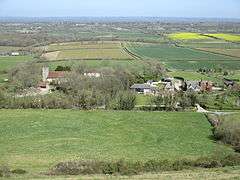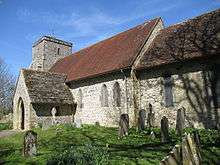Edburton
| Edburton | |
 Edburton seen from the South Downs |
|
 Edburton |
|
| OS grid reference | TQ233114 |
|---|---|
| Civil parish | Upper Beeding |
| District | Horsham |
| Shire county | West Sussex |
| Region | South East |
| Country | England |
| Sovereign state | United Kingdom |
| Post town | HENFIELD |
| Postcode district | BN5 |
| Dialling code | 01903 |
| Police | Sussex |
| Fire | West Sussex |
| Ambulance | South East Coast |
| EU Parliament | South East England |
| UK Parliament | Arundel and South Downs |
|
|
Coordinates: 50°53′21″N 0°14′53″W / 50.88903°N 0.24796°W
Edburton is a small village in West Sussex, England, on the road from Upper Beeding to Fulking.
History
The village's name means Ēadburg's tūn, or settlement. Ēadburg is a woman's name,[1] and it is sometimes claimed that it refers to Edburga of Winchester, a granddaughter of King Alfred the Great and daughter of his successor King Edward the Elder.[2][3] The church supposedly founded by this Edburga c. 940 at Edburton collapsed and was rebuilt in the late twelfth century on the same foundations. This indicates that there was a substantial population living where there are only a few houses now. The situation at the foot of the north-facing South Downs escarpment provided a year-round supply of clean spring water from the chalk of the downs, and access to a range of soil types for farming.
The parish church
The Anglican parish church dedicated to St. Andrew was rebuilt in the late twelfth century, in late Norman and Early English style, beginning with the nave and finishing with the tower. The interior stone came from Caen in Normandy. The well proportioned tower is mainly of flint.[4] There is an unusual lead font with a raisable conical wooden cover. A round stone sink with Anglo-Saxon carving, which was found in the churchyard, is believed to be the piscina of the original Anglo-Saxon church. There are three mass-clocks or sundials carved into the stone on the south side of the church. These originally had a projecting metal rod called a gnomon or style to cast a shadow, and were used to divide up the day before clocks existed. A fourth mass-clock on the north side of the church sees no sunshine and is upside down, showing that the stone was reused from the earlier church, which was built c. 940.

From 1705 to 1716, the rector of St. Andrew's was George Keith, a Scottish-born Presbyterian convert to Quakerism who once served as a leading minister of the Philadelphia Monthly Meeting in Pennsylvania during the late 1680s and early 1690s. Keith's attacks on the political and religious authority of the colony's ruling Quakers initiated a serious schism within Pennsylvania Quakerism during that time. In 1693, after Keith was expelled from the Society of Friends, he published an antislavery tract excoriating Pennsylvania Friends for their involvement in slavery. Keith converted to Anglicanism in 1700 and returned to North America as the first missionary for the Society for the Propagation of the Gospel in Foreign Parts in 1702-1704. Having travelled the world as renowned theologian and missionary, Keith served out the remainder of his years as the rector of St. Andrew's in Edburton, although in his final six years of life he was so sick he often had to be carried to the church to perform his duties.[5]
References
- ↑ Ekwall, Eilert (1991) [1960]. The Concise Oxford Dictionary of English Place-Names (4th ed.). Oxford: Clarendon Press. p. 160. ISBN 0198691033.
- ↑ "Edburton". Towns and Villages Around Worthing. Visitor UK. Retrieved 21 April 2016.
- ↑ Elwes, Dudley George Cary; Robinson, Charles J. (1876). A History of the Castles, Mansions, and Manors of Western Sussex. London: Longmans. p. 85. Retrieved 21 April 2016.
- ↑ St. Andrew's church guide, 2001
- ↑ Ethyn Williams Kirby, George Keith, (New York, 1943), 148-158.